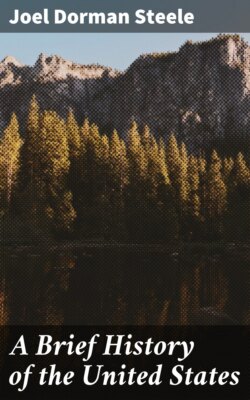Читать книгу A Brief History of the United States - Joel Dorman Steele - Страница 5
На сайте Литреса книга снята с продажи.
INTRODUCTION.
ОглавлениеTable of Contents
WHO FIRST SETTLED AMERICA?—It was probably first peopled from Asia, the birth-place of man. In what way this happened, we do not know. Chinese vessels, coasting along the shore according to the custom of early voyagers, may have been driven by storms to cross the Pacific Ocean, while the crews were thankful to escape a watery grave by settling an unknown country or, parties wandering across Behring Strait in search of adventure, and finding on this side a pleasant land, may have resolved to make it their home.
AMERICAN ANTIQUITIES.—In various parts of the continent, remains are found of the people who settled the country in prehistoric times. Through the Mississippi valley, from the Lakes to the Gulf, extends a succession of defensive earthworks.
[Footnote: It is a singular fact that banks of earth grassed over are more enduring than any other work of man. The grassy mounds near Nineveh and Babylon have remained unchanged for centuries. Meantime massive buildings of stone have been erected, have served long generations, and have crumbled to ruin.]
Similar ruins are found in various other sections of the United States. The largest forest trees are often found growing upon them. The Indians have no tradition as to the origin of these structures. They generally crown steep hills, and consist of embankments, ditches, &c., indicating considerable acquaintance with military science. At Newark, Ohio, a fortification exists which covers an area of more than two miles square, and has over two miles of embankment from two to twenty feet high.
Mounds, seemingly constructed as great altars for religious purposes or as monuments, are also numerous. One, opposite St. Louis, covers eight acres of ground, and is ninety feet high. There are said to be 10,000 of these mounds in Ohio alone.
[Illustration: THE SERPENT MOUND.]
A peculiar kind of earthwork has the outline of gigantic men or animals. An embankment in Adams County, Ohio, represents very accurately a serpent 1000 feet long. Its body winds with graceful curves, and in its wide-extended jaws lies a figure which the animal seems about to swallow. In Mexico and Peru, still more wonderful remains have been discovered. They consist not alone of defensive works, altars, and monuments, but of idols, ruined temples, aqueducts, bridges, and paved roads.
[Illustration: MOUNDS NEAR LITTLE ROCK, ARKANSAS.]
THE MOUND BUILDERS is the name given to the people who erected the mounds of North America. They seem to have emigrated to Central America, and there to have developed a high civilization. They built cities, wove cotton, worked in gold, silver, and copper, labored in the fields, and had regular governments.
THE INDIANS who were found on this continent east of the Mississippi, by the first European settlers, did not exceed 200,000 in number. In Mexico, Peru, and the Indies, however, there was an immense population. The Indians were the successors of the Mound Builders, and were by far their inferiors in civilization. We know not why the ancient race left, nor whence the Indians came. It is supposed that the former were driven southward by the savage tribes from the north.
